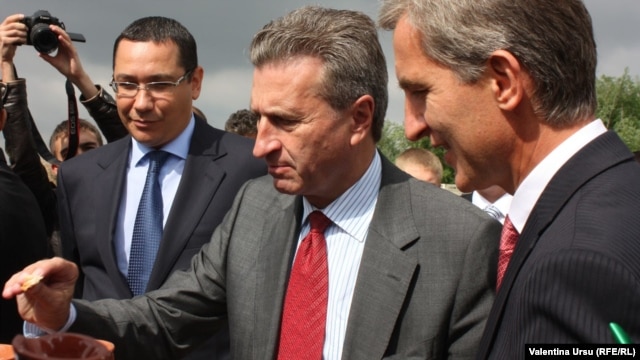Empty Pipeline Shows Difficulty Of Breaking Moldova's Gazprom Addiction
Moldova faces a tough road in its bid to reduce dependence on Russian natural gas.
That's about the only thing that is clear so far in the strange story of the Iasi-Ungheni gas pipeline from Romania to the western border region of Moldova. The gas interconnector -- which cost 28 million euros, including 7 million from the European Union -- was opened to great fanfare at a ceremony on Moldova's National Day -- August 27.
The event was an important photo op for Moldovan Prime Minister Iurie Leanca and Romanian Prime Minister Victor Ponto, both of whom are in the midst of tough election campaigns. The catch is that the shiny pipeline was there, but the gas wasn't.
Leanca announced that it would be at least until October 1 before Romanian gas would flow because of foot dragging by Moldova's natural-gas provider, Moldovagaz. That firm is controlled by Russia's Gazprom, which is eager to remain Moldova's exclusive source of gas.
Leanca has been working to assuage Gazprom. "It is absolutely normal and not at all anti-Russian to want to have two sources of energy," he said on national television on September 25. "That's how you create competition. Prices fall and you get the necessary security."
Breaking its dependence on Gazprom is crucial for the Moldovan government's Eurointegration policies.
The Russian state firm is Moldova's sole supplier of natural gas, which accounts for 65 percent of its energy consumption. In addition, Gazprom holds Chisinau accountable for more than $4 billion in arrears accumulated by the Russia-supported separatist region of Transdniester -- money that the de facto authorities have partially collected from consumers but not passed on to Gazprom.
Moldova pays Gazprom about $420 per 1,000 cubic meters of gas.

It is not known what mechanisms Moldovagaz is using to delay the import of Romanian gas. The company has not issued any statements and did not respond to RFE/RL's requests for comment.
Chisinau-based energy analyst Ion Muntean was quoted by Eurasianet.org as saying he would not be surprised if the pipeline does not begin working before the end of the year.
"There are major interests to block the project," he said.
Huge Potential
Former Moldovan Prime Minister Dumitru Braghis says the legal framework for bringing Romanian gas into Moldova already exists. "That's why we created the National Energy Regulation Agency (ANERE)," he says. "Moldovagaz cannot refuse to transport gas from another source."
However, he added, the firm must first "negotiate a price for transport."
Although Chisinau cannot force Moldovagaz to offer Romanian gas to customers, it should be able to work with partners in Romania and newly created gas companies to do so.
The Iasi-Ungheni pipeline is a small piece of Moldova's energy strategy. In its current configuration, it is only able to provide a small flow of gas to districts right on the country's border with Romania.
But the potential of the entire project is "huge," says Anita Sobjak, a researcher at the Polish Institute of International Affairs in Warsaw.
"This is the very first phase of a grander project," Sobjak told RFE/RL. "This is only a 43.3-kilometer pipeline. What is still missing is the continuation of the pipeline from the Moldovan border to Chisinau, from Ungheni to Chisinau, something like 100 kilometers. More importantly, there are still the gas compressors missing on the Romanian side."
About 200 million additional euros are needed to complete the project. But if it is completed, it has the potential to supply about 1.5 billion cubic meters annually, more than the 1.1 billion that Moldova currently buys from Gazprom.
That is the prize that Prime Minister Leanca is aiming for.
"Gazprom remains our main source of gas," he said on September 25. "But maybe in two years' time, if the pipeline will be fully working, [Gazprom] will also offer us a better price. For us, the main thing is to create competition among energy suppliers."
"If everything goes fine," he added, "[the price of the Romanian gas will be] lower than Gazprom's price and we can attain two goals -- energy security and competitive pricing."
By Liliana Barbarosie and Robert Coalson with reporting from RFE/RL Brussels correspondent Rikard Jozwiak originally appeared at www.rferl.org
Copyright (c) 2014. RFE/RL, Inc. Reprinted with the permission of Radio Free Europe/Radio Liberty, 1201 Connecticut Ave NW, Ste 400, Washington DC 20036.


